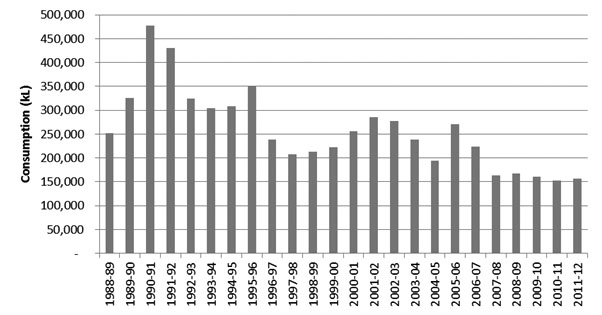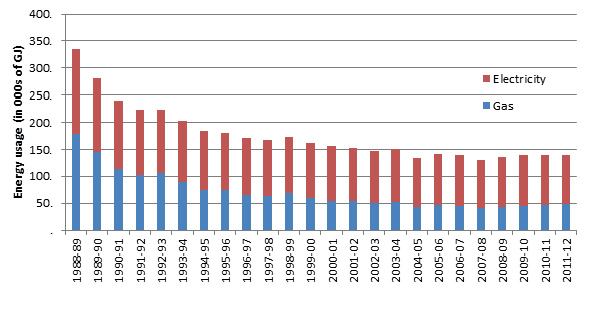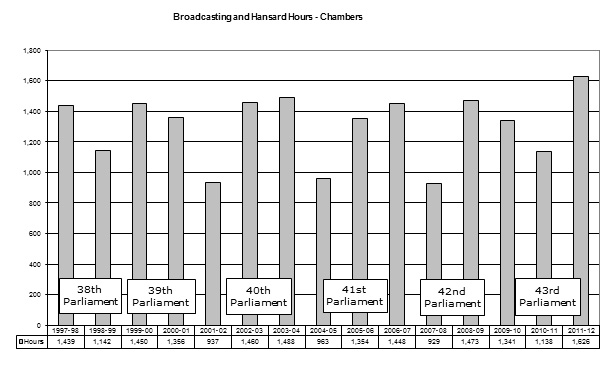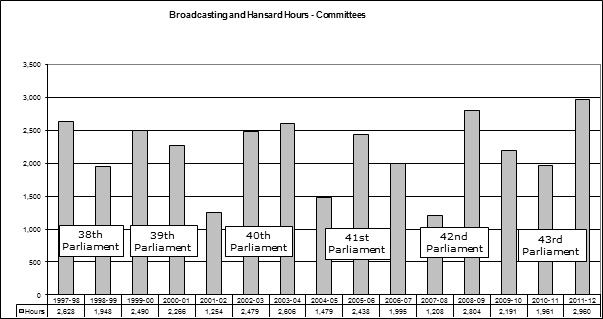Performance overview
In 2011–12, DPS contributed to the integrated services and facilities for building occupants and effective functioning of Parliament by:
- extending ICT services to support portable electronic devices used by Senators, Members and their staff;
- providing a suitable venue for parliamentary activity through building maintenance and provision of building and security services; and
- providing Library, Hansard and broadcasting services to enable members of Parliament to contribute effectively to parliamentary activities.
DPS facilitated access for the general public to the work of the Parliament and its building by:
- welcoming over 850,000 visitors;
- launching the new APH website in February 2012;
- providing 1,626 hours of chamber broadcasts;
- providing 2,960 hours of parliamentary committee broadcasts; and
- providing print-ready Hansard transcripts on the DPS internet site and the web interface to ParlInfo (the parliamentary information search facility).
The effectiveness of our services is assessed through a customer satisfaction survey conducted each parliament that collects customer views on:
- the appropriateness of, and satisfaction with, existing services;
- problems with service delivery;
- identification of service gaps; and
- the extent to which services and facilities are appropriately and conveniently integrated and accessible to assist the user.
The survey for the 43rd Parliament was conducted in mid-2012. Satisfaction levels varied greatly across the range of DPS services. DPS has begun to address the matters arising from the feedback received, particularly in the key areas identified for improvement—catering, ICT services and visitor services.
Each Parliament, the Library commissions a client evaluation of its services. The evaluation for the 43rd Parliament was completed in May 2012 and found high levels of satisfaction with Library services.
Security services
The internal arm of the Parliament House security workforce (the Parliamentary Security Service—PSS) provided almost 24,000 hours of guarding per month in providing access control and security screening for over 850,000 visitors during 2011–12.
Business-as-usual activities revolve around controlling access to the building and protecting building occupants and visitors—with 4,103 new security passes issued in 2011–12. The PSS also managed the security requirements of a particularly heavy international visit program in 2011–12, with 37 visits from 20 countries and six global organisations. Highlights included visits to Parliament House by Her Majesty The Queen and His Royal Highness The Duke of Edinburgh on 21 October 2011; the Honorable Barack Obama, President of the United States of America on 16-17 November 2011; their Royal Highnesses, Crown Prince Frederik and Crown Princess Mary of Denmark on 22 November 2011; and Her Excellency Ms Yingluck Shinawatra, the Prime Minister of the Kingdom of Thailand on 28 May 2012.
A two-year program of major building security upgrades was completed in June 2012. The most notable and visible projects were the construction of the security wall in the public car park; the improvements to perimeter security at the loading dock; and the installation of robust gates at the entrances and exits to the pass-controlled private car parks. Security film was also installed on outwards facing windows. Also worth mentioning is the redevelopment of security entry points between the public and private areas of the building which has improved convenience and efficiency for pass holders moving between the two areas.
Two emergency evacuation exercises were conducted during 2011–12 (August 2011 and March 2012). Real-time and real-situation emergency drills are traditionally difficult to plan and manage where building occupants are part of a mobile workforce, dividing their time between Parliament House and the electorate offices. However, building occupants are becoming increasingly supportive and understanding of the need for these measures. The exercises allow DPS and the ACT emergency services to develop streamlined and well-practised arrangements to respond to a range of emergency situations and to ensure that people who work in the building are familiar with evacuation procedures and assembly points.
The PSS and Australian Federal Police–Uniform Protection (AFP-UP) respond to a range of incidents that impact on or have the potential to impact on the safety and security of Senators, Members, other building occupants and visitors. Such incidents include unattended or suspicious items, suspicious activity, threatening phone calls, malicious mail items, protests or unauthorised building access.
A total of 345 security incidents occurred in 2011–12—ranging from lost property to alarms and protests. The increased number of incidents reported in 2011–12 (225) compared to 2010–11 (112) is driven by a change in reporting by the AFP-UP rather than a higher rate of actual incidents. In 2011–12, the AFP UP reported twice as many incidents as the previous year, by including matters such as surveillance reports which were not previously reported on.
Caring for the building
DPS maintains all aspects of the building—interior and exterior fabrics, electricity, heating and cooling, hydraulic services, and the landscape.
A significant part of the department’s budget is spent on the building asset. It is inevitable that a 25-year-old building will require significant investment in asset maintenance and replacement.
Significant maintenance activities included:
- returfing the areas adjacent to Parliament Drive with water-efficient couch grass, completing the reinstatement of 2 hectares of turf that had died due to the introduction of water restrictions;
- refurbishing 23 Ministerial, Senate and House of Representatives suites, including painting and recarpeting;
- painting 49,500m2 of a total painted surface area of 400,000m2;
- replacing 1,320m2 of carpet and lift ropes in five lifts;
- refurbishing 29 bathrooms and 40 en-suites; and
- replacing 23 glazing panels.
Capital works asset replacement projects undertaken this financial year included:
- upgrading the central energy system—three of the five refrigeration chillers were replaced because of reliability issues and the need to take advantage of efficiency gains from the use of modern technology;
- replacing air handling units in the emergency warning and intercommunication system (EWIS) room;
- replacing the refrigeration leak detection system;
- residual current device (RCD) replacement program; and
- replacing toilet flusherette and irrigation water supply pumps.
Energy efficiency initiatives
The Parliament resolved in August 2011 that Parliament House would participate in the 10% energy efficiency challenge. DPS has always been committed to making energy-efficiency gains and promoting Parliament House as a showcase of environmental good practice. Since the building opened in 1988, energy conservation initiatives at Parliament House have resulted in energy savings of 58%. The further target has been set—to achieve energy savings of 10% by 30 June 2015—against usage in the baseline year of 2009–10. Given that the major efficiency gains have already been achieved, this next 10% will require far more innovation and dedication from both DPS and building occupants if the target is to be met. Many external and seasonal factors beyond DPS’s control will influence success, particularly climate variations and the Parliament’s cyclic pattern. DPS will work with the other parliamentary departments to focus on a range of key measures for reducing energy consumption, including:
- promotion of energy conservation behaviour and work practices of building occupants;
- capital investment to improve building services such as lighting, heating and cooling equipment and metering; and
- equipment fine tuning and building temperature optimisation.
A major initiative for improving the energy efficiency of Parliament House systems is well under way. Around 900 office luminaires (fluorescent lights) which had reached their end of life have been replaced with energy-efficient lights. This will provide a 60% lighting energy saving of 65,600 kWh per year. Also under way is a significant program of upgrades to energy management and measurement systems, including the installation of sensors, controls and meters to monitor and fine tune energy usage across the building.
Energy and water consumption
As part of the department’s energy efficiency program, DPS has succeeded in reducing annual water and energy consumption in recent years. Figures 3 and 4 show the downward trend of water consumption, and electricity and gas usage, respectively, since the building opened.
Total water consumption for 2011–12 was 156,853kL. This represents a small increase compared to 2010–11 due to the reactivation of some water features in the grounds of the building and the relatively lower usage in the previous reporting period as a result of the election year. However, it is still the second lowest year on record.
Figure 3—Annual building and landscape water consumption

Text version of Figure 3
Figure 4—Annual energy consumption

Text version of Figure 4
Landscape water consumption is an area over which DPS has more control. Between 2010–11 and 2011–12 landscape water usage decreased by 4,069 kL (5.5%), the equivalent of 1.6 Olympic-size swimming pools. The initiative taken by DPS to introduce drought-tolerant grass species has seen a downward trend in water use over the last six years. Some credit for the reduction in consumption in the past year, however, must be given to the lower evaporation rates from unseasonal cool weather.
Electricity and natural gas consumption at Parliament House comprised 98%—139,349GJ—of total energy use. In 2011–12, electricity consumption decreased by 3% but natural gas consumption increased by 5%, due to a higher heating requirement for the building as a result of lower autumn and winter temperatures.
The usage trends for both electricity and gas have been relatively stable for some years. However, a very marginal rise in overall consumption (i.e. combined electricity and gas) can be seen in Figure 3, attributable to the greater requirement for heating, as mentioned above, an increasing number of building occupants, and ageing equipment. The last is being managed through maintenance and asset replacement.
During 2010–11, solar panels—with a maximum capacity of 43kW—were installed on the roof of part of the Senate wing and the gardeners compound to test integration with building systems.
As an additional outcome of the successful integration trial, in 2011–12, the total output from the panels was 59,501 kWh, or enough to power the lights in both the Senate and House of Representatives chambers.
Heritage management
DPS has been through a period of significant public scrutiny in a number of areas. In particular, heritage policy and management has been the subject of criticism and review. The department has responded in a number of ways.
Recommendations from the October 2011 Tonkin Review on the department’s processes for the disposal of assets have been acted on and the majority have been completed. DPS’s disposal policies and practices are, as a result, more robust and supported by a strategic approach to heritage assessment in disposal processes.
A Heritage Management Framework was developed and endorsed by the Presiding Officers in November 2011. The framework articulates the heritage values of Parliament House, and guides the development of strategies and plans that protect and raise awareness of those values. One outcome of the framework has been the establishment of the Heritage Advisory Board. The role and membership of this board is included in
Part 5—Sustainability.
Library services
The Parliamentary Library continues to provide an effective knowledge centre for the Parliament through the provision of information, analysis and advice. In 2011–12, the Library:
- answered nearly 15,500 individual client requests;
- released over 420 publications, including 178 Bills Digests;
- introduced new online services including Summon, ParlMap and ebooks;
- added over 4,600 new titles to its catalogue and 185,600 items to its databases and Electronic Media Monitoring Service;
- digitised some 6,700 historic press releases (1959–1999) and completed digitisation of party political documents (policies and major speeches) back to the 1900s;
- recorded over 3.48 million uses of its collection and databases and over 4.8 million online uses of Library publications;
- achieved 33% of titles available online in full text; and
- achieved a 93% satisfaction rate in a client evaluation of Library services, with over 98% of respondents reporting that they would be likely to recommend Library services to colleagues.
Client satisfaction with the Library’s service in the 43rd Parliament is established at 93%, which is the same level recorded in the 2009 DPS Customer Survey and maintains the significant rise in satisfaction from the 89% achieved in the 2007 survey.
Performance against the timeliness target fell below the target of 95%. This reflected in part the increase of some 12% in the number of individual client requests over the previous year and resourcing pressures caused by reduced staff numbers.
More information about the Parliamentary Library’s performance is included in Part 4 of this report.
Building services
Visitors
DPS has a role in supporting democratic participation and Parliament’s engagement with the community.
Parliament House continued to be an important visitor attraction in 2011–12. Overall visitor numbers have increased in the last year, in line with ACT Tourism figures which show a comparable increase in both domestic and international visitors to the ACT. More than 850,000 visitors passed through the doors of Parliament House in 2011–12, a slight increase from 2010–11. Almost 125,000 of these were with the many school groups to which DPS offers tours. To ensure visitor programs remain relevant and popular, DPS conducted a Parliament House visitor survey in early 2012. One key finding was the extent to which visitors valued the opportunity to do self-guided tours. Work commenced in 2012 to enhance the visitor experience based on the survey’s findings.
The department’s attention is not only on visitors to Parliament House, but also on virtual visitors. Better meeting the needs of online visitors was a focus of the APH website redevelopment.
Events
In addition to the busy program of 37 international visits referred to previously, DPS managed 290 parliamentary events and 944 non-parliamentary events.
On 4 June 2012, Parliament House played a major role in the celebration of Her Majesty Queen Elizabeth II’s Diamond Jubilee. The building was one of many locations around the world to hold a beacon lighting ceremony to celebrate the Queen’s 60-year reign.
DPS managed the temporary exhibition program in the Presiding Officers’ Exhibition Area. The House of Representatives presented My First Speech. Three exhibitions were presented by external organisations: In the Line of Duty: Women in Policing from the Australian Federal Police; Mawson’s Men: 100 Years of Antarctic Exploration from the Australian Antarctic Division; and Grand Visions: The Centenary of the Capital Plan from the National Capital Authority. One in-house exhibition, Faithful Representations: 100 years of the Historical Memorials Collection, was presented.
DPS celebrated the centenary of the Historic Memorials Collection (HMC) in December 2011. This occasion was marked with special exhibitions at Parliament House and the National Portrait Gallery, and a presentation of a Senate Occasional Lecture on the history of the collection by the DPS Director, Art Services.
Childcare
In February 2012, the Capital Hill Early Childhood Centre celebrated three years of successful operation under the management of Anglicare Canberra and Goulburn. Childcare places were at or near capacity throughout the year.
Hansard and broadcasting services
As well as providing services within Parliament House, DPS provides audio-only or audio-visual support to the many committee hearings across Australia every year.
One of the challenges in parliamentary reporting is how to manage the workload in response to fluctuating sitting patterns and sitting hours each year. Although a rise in parliamentary activity is quite normal for the middle period of a parliamentary cycle, the number of chamber and committee hours increased considerably in 2011–12. To ensure that DPS can respond to the changes, a number of measures are used to improve efficiencies, including the engagement of casual staff as required.
Parliamentary committee activity achieved historically high levels in 2011–12. Committee transcripts typically make up more than 60 per cent of the overall Hansard workload. The number of hours of committee proceedings increased from 1,961 in 2010–11 to 2,960 during the reporting period. Despite the increase in sitting hours, Hansard and Broadcasting maintained a high level of service to committees, and performance against accuracy and timeliness indicators was improved. The proportion of individual transcripts (chambers) delivered within timeframe targets increased from 83.2% in 2010–11 to 86% in 2011–12—and 97.8% in the May to June quarter.
Figures 5 and 6 show the number of hours of chamber sittings and committee proceedings recorded, respectively, between 1997–98 and 2011–12.
Figure 5—Broadcasting and Hansard—Chamber Hours 1997–98 to 2011–12

Text version of Figure 5
Figure 6—Broadcasting and Hansard—Committee Hours 1997–98 to 2011–12

Text version of Figure 6
Information and communications technology services
DPS provides services to over 4,800 registered ICT users in Parliament House and electorate offices, covering services from training and assistance to support for software and hardware and desktop and mobile computing to printers, televisions and pagers.
Demand for IT help desk services remained high in 2011–12, with over 48,000 requests for support—9% higher than in 2010–11.
A program of major upgrades to ICT systems and infrastructure included the rollout of Windows 7 and Office 2010 to replace older platforms. A new APH website went live on 17 February 2012 and further updates of the Hansard production system (HPS) were initiated (and completed in July 2012).
Major computing infrastructure upgraded during the year included remote access services and data storage systems, allowing much greater data to be added to the storage area network (SAN) to cater for growth in server and email demands.
An important development in late 2011 was the finalisation of the transfer of Electorate Office IT (EOIT) support from the Department of Finance and Deregulation to DPS.
The additional functions to support the electorate offices now under the responsibility of DPS include onsite ICT support, ICT training and the management of the communication network to the electorate offices. The Department of Finance and Deregulation has retained responsibility for certain entitlements such as the provision of mobile phones, including BlackBerry devices.
In 2011–12, DPS expanded ICT services to parliamentarians and their staff by facilitating the connection of their own mobile electronic devices to the PCN. This has allowed users to receive real-time access to email, the internet and diary information. The new service primarily involves the connection of iPhones and iPads but will include other devices over time. The connection of BlackBerry devices has been supported for a number of years.
These new responsibilities and challenges—ICT support to the electorate offices, the fast-changing environment of mobile computing and the ever-growing security threats to the network and data—will be considered as a high priority in future ICT strategic policy. To that end, the Presiding Officers commissioned former senior public servant, Mr Michael Roche, to conduct a review of ICT services for the Parliament. The main purpose of the review is to examine the management and delivery of ICT services to meet the needs of parliamentarians, their staff and the parliamentary departments. New initiatives arising from the review will be implemented in 2012–13 and a new IT governance framework will be developed with all key stakeholders represented.
Customer satisfaction
Overall customer satisfaction varied across the direct and facilitated services managed by DPS.
Of those that are directly managed by DPS, ICT services and visitor services have been identified as priority areas for improvement. Of the facilitated services, catering is the main area of focus for improvement.
The department is pleased that the high satisfaction levels of the Parliamentary Library have been maintained.